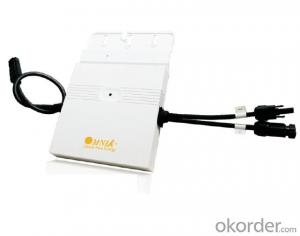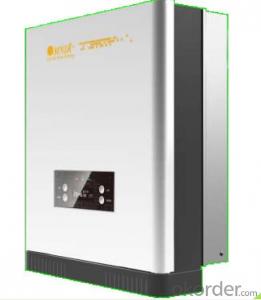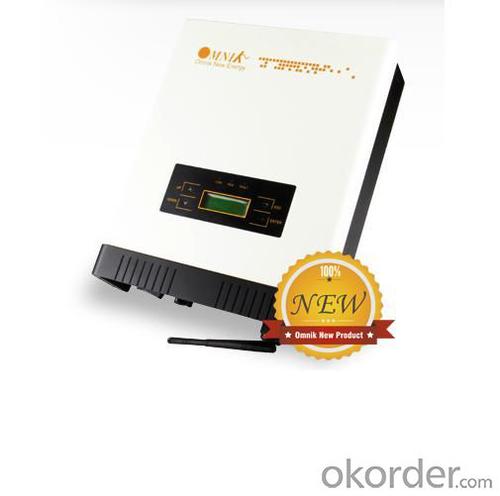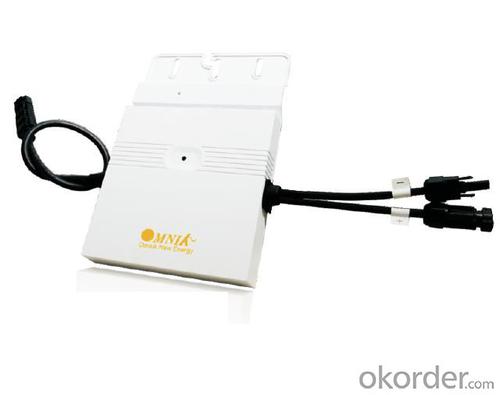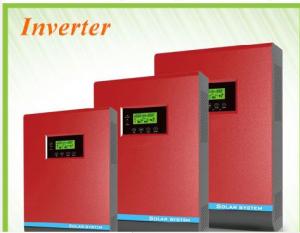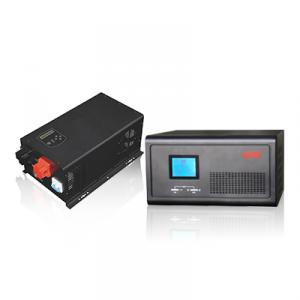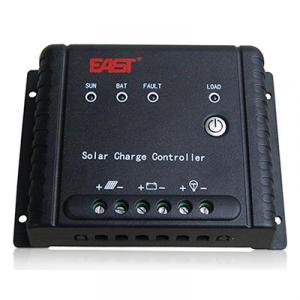Indian Solar Inverter On Grid Solar Inverter Omniksol-1.0k-TL2
- Loading Port:
- Shanghai
- Payment Terms:
- TT OR LC
- Min Order Qty:
- 12 pc
- Supply Capability:
- 3000 pc/month
OKorder Service Pledge
OKorder Financial Service
You Might Also Like
Omnik new energy solar inverter
Omniksol-2.0k-TL Photon Efficiency up to 3kW
in the world------ Photon tested Jan. 2012.
Omniksol-1.0k-TL2
1.Futures
Built-in GPRS as option
Built-in Wifi as option
External inductor and built-in fan
smaller and lighter, 2k only 9.6kg
High performance DSP for algorithm control
VDE-AR-N 4105 certification
Self-developed topology design
Multi-button touch interface
LCD screen visible at night
10 years warranty(5~15 years as option)
2.Technical data:
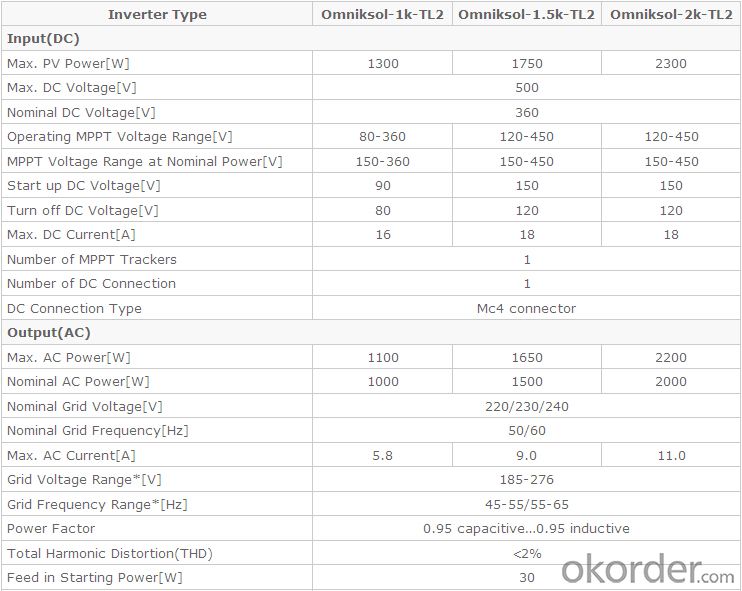
3.product certificate
EN 61000
VDE 0126-1-1
C10/11
G83/2
UTE C15-712-1
AS4777
CQC
CE10-21
EN50438
4.Product outlook
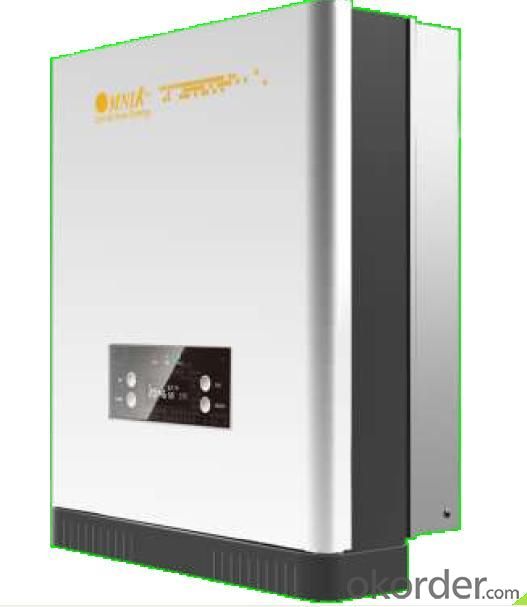
1. How long will my inquiry get response?
Your inquiry related to our products or prices will be replied within 24 hours.
2. Can I get professional service and suggestion?
Well-trained and experienced staffs to answer all your questions in fluent English.
3. Do you accept OEM or customized design?
OEM & ODM, any your customized lightings we can help you to design and put into product.
4. What if I need specific design?
Distributorship are offered for your unique design and some our current models.
- Q: Can a solar inverter be used in systems with different module capacities?
- Yes, a solar inverter can be used in systems with different module capacities. Solar inverters are designed to convert the DC power generated by solar panels into AC power that can be used in homes or businesses. They are typically designed to handle a range of module capacities and can be adjusted or configured to accommodate different system sizes. However, it is important to ensure that the inverter's capacity is compatible with the total capacity of the solar panels in the system to ensure optimal performance.
- Q: How does a solar inverter prevent reverse current flow?
- A solar inverter prevents reverse current flow by using built-in diodes that act as one-way valves, allowing electricity to flow only in the desired direction from the solar panels to the grid or battery system.
- Q: Can a solar inverter be used with a solar-powered air conditioning system?
- Yes, a solar inverter can be used with a solar-powered air conditioning system. A solar inverter is responsible for converting the direct current (DC) produced by solar panels into alternating current (AC) that can be used to power appliances. In the case of a solar-powered air conditioning system, the solar inverter enables the AC produced by the solar panels to be used by the air conditioning unit. This allows for the efficient use of solar energy to power the air conditioning system, reducing reliance on the grid and promoting sustainability.
- Q: How does shade affect the performance of a solar inverter?
- Shade significantly impacts the performance of a solar inverter by reducing the overall energy production. When a solar panel is partially shaded, it creates multiple voltage levels throughout the array, leading to a decrease in the overall power output. This shading effect causes the inverter to work inefficiently as it struggles to optimize energy conversion. Consequently, shade can significantly hinder the performance and efficiency of a solar inverter.
- Q: Can a solar inverter be used with different types of solar charge controllers?
- Yes, a solar inverter can be used with different types of solar charge controllers as long as they are compatible in terms of voltage and communication protocols. However, it is important to ensure that the solar inverter and charge controller are properly matched to ensure optimal performance and safety.
- Q: What is the role of a solar inverter in a solar-powered electric vehicle charging station?
- The role of a solar inverter in a solar-powered electric vehicle charging station is to convert the direct current (DC) electricity generated by the solar panels into alternating current (AC) electricity, which is suitable for charging electric vehicles. It ensures the compatibility between the solar energy and the charging station's electrical infrastructure, allowing for efficient and reliable charging of electric vehicles using clean and renewable solar power.
- Q: How does a solar inverter handle voltage unbalance?
- A solar inverter handles voltage unbalance by continuously monitoring the phase voltages of the grid. If a voltage unbalance occurs, the inverter adjusts its output voltage and frequency to maintain a balanced supply to the grid. This ensures that the solar inverter can efficiently convert the DC power generated from the solar panels into AC power that is synchronized with the grid, despite any voltage imbalances.
- Q: What is the role of a voltage control unit in a solar inverter?
- The role of a voltage control unit in a solar inverter is to regulate and stabilize the voltage of the direct current (DC) power generated by the solar panels before it is converted into alternating current (AC) power. It ensures that the voltage remains within the desired range to optimize the efficiency and performance of the solar inverter, as well as protect the connected appliances or grid from potential damage due to voltage fluctuations.
- Q: Can a solar inverter be used with a single solar panel?
- Yes, a solar inverter can be used with a single solar panel. The purpose of a solar inverter is to convert the direct current (DC) produced by the solar panel into alternating current (AC) that can be used to power electrical devices or be fed into the electrical grid. Even with a single solar panel, the inverter can still perform this function effectively.
- Q: What is the role of a solar inverter in anti-islanding protection?
- The role of a solar inverter in anti-islanding protection is to detect and prevent the occurrence of islanding. Islanding is a situation where a solar PV system continues to generate power and feed it into the grid during a power outage, which can pose a safety risk to utility workers attempting to restore power. The solar inverter monitors the grid voltage and frequency and when it detects an abnormality, such as a loss of grid connection, it quickly disconnects the PV system from the grid. This anti-islanding protection feature ensures that the solar system does not operate independently and helps maintain the safety and stability of the electrical grid.
Send your message to us
Indian Solar Inverter On Grid Solar Inverter Omniksol-1.0k-TL2
- Loading Port:
- Shanghai
- Payment Terms:
- TT OR LC
- Min Order Qty:
- 12 pc
- Supply Capability:
- 3000 pc/month
OKorder Service Pledge
OKorder Financial Service
Similar products
Hot products
Hot Searches
Related keywords

